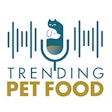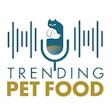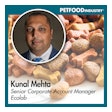
In a special episode recorded live at Interzoo 2024, Lindsay Beaton interviews Wilbert van de Corput, area manager with OPEM and member of the Petfood Competence Network. Together they discuss the challenges and opportunities within sustainable packaging in Europe, focusing on the evolving regulations and the industry's efforts to innovate sustainable practices. The episode highlights the importance of clear legislation and the role of experts in driving meaningful change in pet food packaging.
The below transcript is from Episode 65 of the Trending: Pet Food podcast. Host Lindsay Beaton talks with Wilbert van de Corput, area manager with OPEM and member of the Petfood Competence Network, about the status of sustainable packaging in Europe, including evolving regulations and innovative sustainable practices. You can find the episode at Trending: Pet Food, on SoundCloud or on your favorite podcast platform. This episode originally aired on July 3, 2024.
We want to thank AFB International for sponsoring this podcast. AFB is the premier supplier of palatants to pet food companies worldwide, offering off-the-shelf and custom solutions and services that make pet food, treats and supplements taste great.
Lindsay Beaton – editor, Petfood Industry magazine, and host, Trending: Pet Food podcast: Hello, and welcome to Trending: Pet Food, the industry podcast where we cover all the latest hot topics and trends in pet food. I’m your host and editor of Petfood Industry magazine Lindsay Beaton, and I’m here today, live at Interzoo 2024, with Wilbert van de Corput, area manager with OPEM S.p.A. and member of the Petfood Competence Network. Hi Wilbert, and welcome.
Wilbert van de Corput, area manager with OPEM S.p.A. and member of the Petfood Competence Network: Hi, Lindsay. Good morning.
Beaton: In case you’re not familiar with Wilbert, OPEM or the Petfood Competence Network, here’s what you need to know.
Wilbert is an expert in packaging, with extensive experience in packaging machinery sales, both primary packaging and shrink-sleeve application, currently representing OPEM mainly for pet food, coffee, and yeast applications. He has a particular specialty in sustainable packaging, including leading projects on reduced thickness and recyclability of shrink-sleeve packaging, biobased flexibles and compostable flexibles. Wilbert is also a member of the VNV, the Dutch Association of Packaging Experts.
OPEM is an Italian VFFS and vacuum packaging machine supplier for dry pet food, with a unique system that produces a recyclable mono-PE bag with dosing and a reclosing spout with a screw-cap that in the future could even be used for refilling.
The Petfood Competence Network is a group of 11 companies that represent the complete pet food industry supply chain, from ingredients to processing to packaging, both for wet and dry pet food.
Wilbert’s long-time packaging experience and expertise, particularly in the sustainability aspects of packaging, are why I’ve brought him on today to answer this question: What are the current challenges and opportunities within sustainable packaging in Europe?
I think to start out, we should probably talk about what the current state of sustainable packaging is. What are things looking like right now in Europe?
van de Corput: At the moment, Europe is in the phase of change. The packaging and packaging waste directive is in place now, which means that there are some guidelines but no rules. Every single country has its own interpretation of the challenges. In my case, flexible packaging. One material in Italy can be considered very well recyclable where in the Netherlands, it will not be accepted as recyclable, just to give you an example.
The idea now is that in 2025, it will be a new situation where we will have the packaging and packaging waste regulations. So no longer a directive, but regulations. The challenge is that in Europe, every single country will have the same playing field, the same targets, the same goals. That's where we are at now.
There's a little bit of the chicken and the egg situation -- should we now do a lot in moving towards recyclable or compostable packaging? While we know that in practice, these materials are not being recycled or composted or whatever. Should we wait until we have the situation in place where materials are being recycled? I'm still undecided about this, to be honest. It can be interesting to start doing it, to develop. But it's also sometimes good to slow down and ask, okay, what's happening with this? Because we are investing a lot of money and time and resources in finding solutions, which in the end may not all be necessary.
Beaton: Let's talk about the regulations that are coming out next year. What are some of the high points of those regulations? And what is it going to mean for packaging?
van de Corput: The most important for Europe is to get one same regulation – all on one playing field. That's the most important target. The other items, like recyclable, reusable, reduction, the three Rs that we are aiming at. To reduce the amount of packaging; to recycle, there are different ways, mechanical recycling, or chemical recycling. Those are the important topics.
Beaton: Is the main thing that every country will be following the same regulations starting next year? Are they going into effect immediately or do countries have a certain number of years to comply?
van de Corput: They will have a number of years to comply. The aim is for 2030, which is quite challenging. But we have time to comply.
Beaton: What are the top challenges right now in Europe when it comes to sustainable packaging? We talked a little bit about how countries all have different regulations, we have those problems in the United States, in particular, the infrastructure is different in every state, and sometimes in every city within the state. You can have all the recyclable packaging you want, but if the infrastructure isn't there, like you said, it's not going to get recycled anyway. Is that a challenge here as well?
van de Corput: I always say follow the money. And basically, at the moment, the waste industry is an interesting business case, where the main target is capitalist continents. Everybody wants to make profit.
What we've done over the last decade is create a system where we are dividing or sorting already as a consumer, our waste, paper, glass, cans, tins, plastic, all in different cubes. In the past, basically, you would throw it all together, one truck would come in, pick it all up and bring it immediately to the incinerator or landfill. Now, we are sorting it as a consumer, five different trucks come in and bring it to the sorting companies, they all sort it out. Then they bring it to the recycling companies. They don't recycle. A lot of it is not being recycled. Then it all ends up in incineration.
Every single person is making money out of this. This is one of my frustrations. On the other hand, it's necessary, perhaps, to get somewhere, but I think we should be more critical about this situation.
But five years ago, I developed the first industrial compostable packaging for coffee. The packaging was certified industrially compostable. Within eight weeks, the material would disappear as compost. We had a lot of people from the composting company that did not want to have this material.
If you will talk to the technical people, they were all excited. “This is great. We want testing!” But then management says, “No way are we are going to do this.” Why? Because their business model was to compost everything within four weeks. In this case, the material would not completely compost within that time. According to all the regulations, all the directors, it was in fact compostable, it worked.
Then they came up with excuses, like it does not add to the quality of the compost or blah, blah, blah. In the end, it was against their business model. They couldn't make money. Also, orange peels and banana refuse don’t compost within four weeks.
In the end, a lot of it's after the composting is also used in incineration. So basically, we developed this over a few years, but then in the end, it's not used.
Another item is the money. The cost of compostable, biobased, versus the normal material. If a normal material was … let's say it cost $100. A biobased alternative would cost you $200 and compostable alternatives with close to $300. This is another reason why big companies, big multinationals didn't want to move too much towards compostable and biobased, even though they are very good alternatives for the environment.
We are now looking more at recycling -- the most economical, less expensive route to follow and still be sustainable. That's a lot of variables influencing this situation. Money is always an interesting one to follow.
Beaton: We haven't even started talking about what consumers or the end user thinks of all of this. In Europe, are different countries in different places -- in terms of their populations -- into recycling? How into sustainability are they? What is the education like? Does the average consumer recycle? Do they know what they're doing?
van de Corput: The average consumer has no clue what's happening. No clue whatsoever. Many times, when I have dinner with friends – I’m at the birthday party or something like that – the topic comes up because they know I work in packaging. They ask me, “Well, what do you think?” I explain to them, for instance, this example of the compostable material and what's happening with waste. In the Netherlands, we saw about 50% to 55% of the polyethylene sorted by the sorting companies and brought to recycling companies. For them, that's 100% of the supply. At the moment, 10% of the material is being recycled. It's not actually recycled at all. From there, it goes to the incineration where it's mixed with green waste. This is the situation.
Should we do this? Should we now develop monopolyethylene materials? Of course, the sorting companies and the recycling companies are making progress. They are investing. They will one day arrive. But in the meantime, there are also developments in chemical recycling, which could be much more interesting. There, you will not need to have mono-material. We could all continue with a complex laminate like polyester polyethylene that you can chemically recycle again. Two ingredients that you can again use for the same purpose.
Mechanical recycling is always a downgrade. You cannot use the material again for food. A lot of things must change. Legislation must change, the applications for foods and pricing. Now, virgin plastics are cheaper than recycled plastic. It's a big mess.
Beaton: If you were the one making the dates by which things need to be sorted out – there are regulations coming in next year, and they're giving them five years or so to get everything together -- realistically, where do you think the industry is actually at? How far away are we from realistically making all of this happen?
van de Corput: Minimum 20 years, to be honest.
Beaton: Really? Is a lot of that problems that we've already covered? Is there anything else at play? Is it more on the regulatory side?
van de Corput: It’s already possible, I would say. It’s the will to really do it. The only way is, I think it's now in the hands of the politicians. They need to make clear legislation. Hopefully listen to the experts. Make the right decisions -- that's also a possible danger. We need clear legislation, and hopefully now with this new packaging, waste regulation coming up, this will give a clearer view.
I have my own opinion. For instance, if you look at flexible packaging, not everything can be made from polyethylene. Polypropylene, for instance, would be a better solution for flexibles. Why? Polyethylene you cannot use for sterilizable bags. With polypropylene, there are more possibilities in machine applications. From my point of view, the direction should be to move all flexibles to polypropylene, and all rigid plastics to polyethylene.
Today, you don't need any signals or certifications or signs or logos on your packaging. If it's flexible, it’s polypropylene. If it’s ridgid, it's polyethylene. That would make things very easy and feasible, technically, as well.
Beaton: You said that they prefer to recycle rigid and not flexible?
van de Corput: Ridgid is easier. Ridgid plastics tend to be 100% polyethylene. Flexibles, many times have inks, glues, adhesives … it’s more difficult to clean them and they have less weight. It's the easiest way to make a little bit of money from the recycling.
Beaton: We've been talking a lot about the challenges and the roadblocks. What do you think are the opportunities in sustainable packaging, whether we've realized them yet or not? What could the future look like if this all comes together?
van de Corput: I’ve been working 30 years in packaging, the first 20-25 years were stable, nothing changed really. Over the last five to eight years, a lot has changed. It's an industry, changing situation, doing a lot of research. The mindset has changed. This is important for developments. There are new innovations. For instance, PEF (polyethylene furanoate) for bottles. PEF is a natural biobased material, which will in the end, replace PET bottles. It can go straight into the PET recycling. PEF has better properties. It’s even better than PET. This would not have happened if nothing had changed. I'm sure they will come up with new, flexible packaging materials as well, whether it's biobased or not. So the mindset has changed, and that's the most important thing. I think the idea that this can happen by 2030, would be nice.
Beaton: It does sound very complicated, and like there is a lot going on. What happens if companies can't make it happen by 2030? Is that built into the regulations? Or do you think they're going to have to adjust it in four and a half years?
van de Corput: They must be recyclable. Now we already understand that everything is recyclable technically. I remember, I think it was 25 years ago, the company I worked with then was in coffee, it was a complex laminate-like polyethylene aluminium that was standard. That changed to metallized polyester polyethylene, so they changed the aluminium to a metallized polyester. The big announcement was it was recyclable. It was recyclable, but nobody recycles it. If you continue to use “recyclable” as a target, then we are already there -- guaranteed to be recycled.
Beaton: That's the more complex part of the infrastructure and then getting everybody on board and actually doing it.
van de Corput: I don't think there will be the materials themselves. If they're not there, then 2030, nothing really will happen. Maybe they will have to pay more tax on certain materials. But that's it.
Beaton: Well, thank you very much for being here with me today. Because packaging and sustainable packaging is such a hot topic globally right now, and it sounds like a lot of the things that are going on in North America are happening here as well, but you have the complexity of different countries trying to get all together and regulating everything. But all the things you mentioned, the things are technically recyclable, but the infrastructure is not there, or the consumers don't know what to do or following the money. Those are global issues right now. It's interesting to see how they're playing out in different regions of the world and how similar the issues are even when the regulations are different, and countries are at different places with their recyclability and their sustainability.
Before we go, I want to do a little plug. Where can people find more information about you, OPEM, and the Pet Food Competence Network?
van de Corput: We have our website, petfoodcompetencenet.com. There, you can find all the details. It's a group of 11 companies giving you the complete supply chain for the greenfield project, whether it's wet or dry. Everything's there -- ingredients processing, packaging. Myself, I work with OPEM, an Italian machine supplier. You can find me on their website as well, at opem.it. Myself, you can find me on LinkedIn at Wilbert van de Corput.
Beaton: Perfect. That's it for this episode of Trending: Pet Food, live at Interzoo 2024. You can find us on petfoodindustry.com, SoundCloud or your favorite podcast platform. You can also follow us on Instagram @trendingpetfoodpodcast. And if you want to chat or have any feedback, I'd love to hear from you. Feel free to drop me an email: [email protected].
And of course, thanks again to our sponsor AFB International, the premier supplier of palatants to pet food companies worldwide, offering off-the-shelf and custom solutions and services that make pet food treats and supplements taste great.
Once again, I'm Lindsay Beaton, your host and editor of Petfood Industry magazine, and we'll talk to you next time. Thanks for tuning in!

















